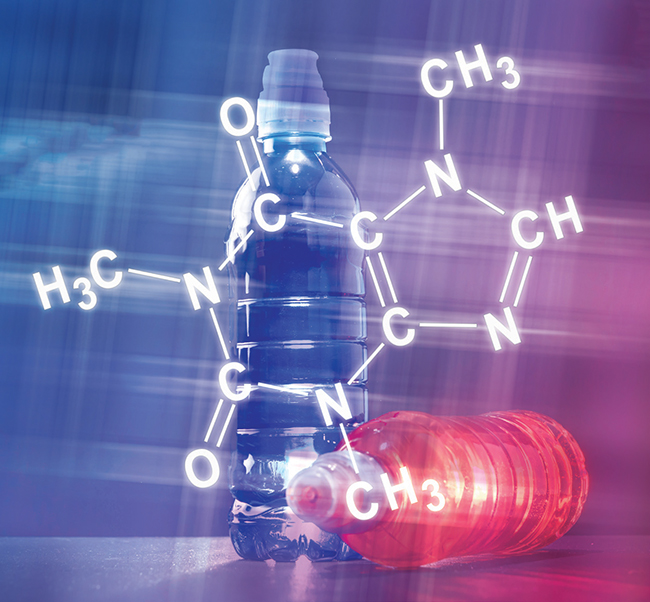First Drop: Something You Can Feel
There’s a fairly regular pivot we’ve seen many functional beverage brands make when they are having trouble gaining traction: they turn to caffeine.
The addition of that wonderful compound, with its incredible ability to make our minds feel more awake than they have any right to be, is one way that a product whose more holistic, subtle, hard-to-feel functional effects (we used to call them “long-lead functionalities – as in, you’ll know they’ve worked if you pass away sometime after you would have died before you started taking them) can start to feel like it’s working pretty much right away.
In other words, the ginseng or amino acids or CBD-laced water that you drank might not otherwise cause you to feel anything (whether or not they’re actually working to provide you benefit). But when you deal in a lot of holistic additives your results tend to vary with your own, uh, faith in their experiential effects, and caffeine is one of those things whose systemic benefits are near-immediate, palpable and – even better – addictive. Once you start getting into the habit of using it as part of your functional beverage routine, you notice a difference when it’s gone.
And for some products, the addition of caffeine can definitely charge sales as much as it charges the consumer. Certainly we’re seeing that with Odyssey, the functional mushroom product that recently launched a “222” line, which adds a hefty 2-cup-of-coffee kick to its Cordyceps and Lion’s Mane fungi mix.
One set of products that has only recently started to work with caffeine is the hydration space, where Gatorade Fast Twitch has catapulted that long-time brand into the energy drink realm with a product that dumps 200 mg of caffeine into the category leader’s trademark blend of electrolytes. It’s a potent mix – that’s more than two regular Red Bulls in a chuggable 12 oz. bottle – but it’s one that has long been so long in the offing it makes one wonder why it took so long to get there.
That’s not because there’s competition for Gatorade from inside the sports drink category – although we do believe that Body Armor may yet find a second, generational wind, and that Prime remains an unpredictable competitor – but from a constellation of other product types that have moved in on its core market, exercise.
Right now much of the growth in the energy drink category, in fact, is coming from hyper-caffeinated products that fit a gym rat’s mentality. Everything from Celsius to Ghost to C4 to Alani Nu to, yes, strange bedfellows Bang and Reign are designed to feel at home in the cupholder of the health-club bound. If these brands have proven a commercial viability for something that trainers, scientists, and baseball players who chug Red Bulls between innings have long known – that well-timed doses of caffeine can improve athletic performance – Gatorade has slowly come to understand that the workout space has more to it than electrolyte replenishment.
But energy products aren’t the only ones forcing Gatorade and its traditional competitors into a competitive stance. With new brands on board, right now there’s something of an electrolyte arms race, one that includes both powdered and liquid formats. In the past decade, the rapid growth of both powdered and liquid brands like Electrolit, LMNT, Hydrant, Biolyte, Liquid IV and others have brought a new level of functionality to the rapid rehydration game, creating a premium, almost clinical subcategory that demands the attention of the established brands.
These saltier solutions tend to have a higher concentration of electrolytes, making them popular among athletes and among those who might be depleted from that other great recreational activity, boozing. Once again, though, it’s a move into Gatorade territory, both among elite athletes and elite partiers alike. Morning after recovery has long been one of Gatorade’s great unspoken uses; with the growth of actual IV infusions as an achievable – albeit elite – hangover relief possibility, products in the mold of Liquid IV were sure to follow.
Whether it’s for competitive sports or competitive drinking, the identification of this super-hydration space by these insurgent brands has led Gatorade and Body Armor to lean into the trend via rapid relief products of their own, like Gatorlyte and Flash. Pedialyte itself is aiming for a more commercial approach, watching its popularity among athletes and celebrities create a secondary use market that transcends the clinical.
As this electrolyte arms race cranks up, one has to wonder if there’s a crackdown coming — if not from regulators, who have once again started to look at the energy space over, among other things, the caffeine in PRIME, a brand that has feet in both the energy and sports drink worlds — than from doctors and sports medicine experts themselves. They’ve long been clear that in most cases, hydration is perfectly achievable through basic H2O, and that recovery is as well served by chocolate milk as by Gatorade.
And the brands like Gatorade and Body Armor recognize this as well, extending their brands into water – but for heavy use cases, whether it’s after a long run or a long night out, electrolyte based hydration is one of the few other areas that a consumer can actually “feel” working. Now, chugging water is certainly a fine way to rehydrate in most cases, but throw a sports drink to someone who is hurting from fluid loss – for whatever reason – at the right time, and see them feel better, and you’ve probably won a convert.


Receive your free magazine!
Join thousands of other food and beverage professionals who utilize BevNET Magazine to stay up-to-date on current trends and news within the food and beverage world.
Receive your free copy of the magazine 6x per year in digital or print and utilize insights on consumer behavior, brand growth, category volume, and trend forecasting.
Subscribe